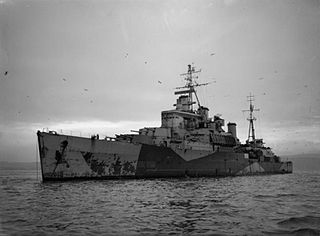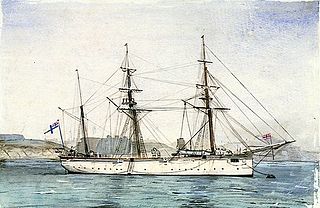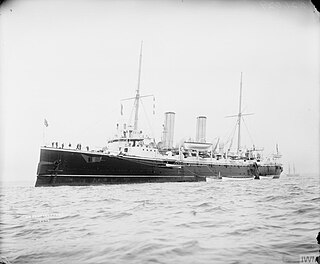
HMS Newfoundland was a Fiji-class light cruiser of the Royal Navy. Named after the Dominion of Newfoundland, she participated in the Second World War and was later sold to the Peruvian Navy.
Six ships and a training establishment of the Royal Navy have borne the name HMS Imperieuse:
Three ships and one shore establishment of the British Royal Navy have been named HMS Collingwood, after Admiral Cuthbert Collingwood, 1st Baron Collingwood:
Five ships and one shore establishment of the Royal Navy have borne the name HMS Dauntless:
Five ships and a shore establishment of the Royal Navy have borne the name HMS Calliope after the muse Calliope in Greek mythology:

HMS Caroline is a decommissioned C-class light cruiser of the Royal Navy that saw combat service in the First World War and served as an administrative centre in the Second World War. Caroline was launched and commissioned in 1914. At the time of her decommissioning in 2011 she was the second-oldest ship in Royal Navy service, after HMS Victory. She served as a static headquarters and training ship for the Royal Naval Reserve, based in Alexandra Dock, Belfast, Northern Ireland, for the later stages of her career. She was converted into a museum ship. From October 2016 she underwent inspection and repairs to her hull at Harland and Wolff and opened to the public on 1 July 2017 at Alexandra Dock in the Titanic Quarter in Belfast.
Nineteen ships and a shore establishment of the Royal Navy have been named HMS Drake after Sir Francis Drake or after the drake:
Five ships and a number of shore establishments of the Royal Navy have borne the name HMS Daedalus, after the mythical Daedalus:

HMS Ariadne was a Diadem-class protected cruiser of the Royal Navy, which was launched in 1898, In March 1913, she was converted to a stokers' training ship and in 1917 was converted to a minelayer and assigned to the Nore Command. She was torpedoed and sunk off Beachy Head by the German submarine UC-65 on 26 July 1917.

HMS Flora was an Astraea-class cruiser of the Royal Navy launched on 21 November 1893. She was constructed under the Naval Defence Act 1889 along with several other Astraea-class cruisers. Flora was decommissioned in 1922.

HMS Fisgard was a shore establishment of the Royal Navy active at different periods and locations between 1848 and 1983. She was used to train artificers and engineers for the Navy.

HMS Ganges was a training ship and later stone frigate of the Royal Navy. She was established as a boys' training establishment in 1865, and was based aboard a number of hulks before moving ashore. She was based alternately in Falmouth, Harwich and Shotley. She remained in service at RNTE Shotley until October 1976.

HMS Dryad was the name ship of the Dryad-class torpedo gunboats. She was launched at Chatham Dockyard on 22 November 1893, the first of the class to be completed. She served as a minesweeper during World War I and was broken up in 1920.

HMS Spartan was an Apollo-class cruiser of the Royal Navy constructed in 1891. The design was a variant of the Marathon-class cruiser. The ships had quick firing guns which were effective as a broadside, but less so when attempting to fire fore or aft.

HMS Mariner was the name-ship of the Royal Navy Mariner-class composite screw gunvessel of 8 guns.

HMS Racer was a Royal Navy Mariner-class composite screw gunvessel of 8 guns.

HMS Artifex was a repair ship of the Royal Navy from late in the Second World War and into the Cold War. Launched as the Cunard liner RMS Aurania she was requisitioned on the outbreak of war to serve as an armed merchant cruiser. Damaged by a U-boat while sailing with an Atlantic convoy, she was purchased outright and converted to a floating workshop, spending the rest of her life as a support ship for the navy.

The Astraea class was an eight ship class of protected cruisers built for the Royal Navy during the 1890s. The ships served on a number of foreign stations during their careers, particularly in the waters of the Indian and Pacific Oceans, and around the Cape of Good Hope. Already obsolete by the outbreak of the First World War, most continued to see service in a variety of roles, though rarely in a front line capacity. By the end of the war the majority were being used as training or depot ships, and they were soon sold out of the service and scrapped. However one ship, HMS Hermione, was bought by the Marine Society and used as a training ship until 1940.

HMS Bonaventure was an Astraea-class second class cruiser of the Royal Navy, ordered as part of the eight-ship Astraea class under the Naval Defence Act of 1889. She was commissioned for service in 1895, and survived to serve in the First World War.













